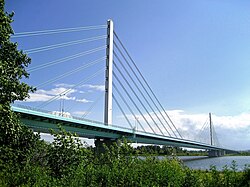Solidarity Bridge | |
|---|---|
 | |
| Coordinates | 52°31′18″N 19°43′39″E / 52.521667°N 19.7275°E |
| Carries | 4 lanes (motor vehicles) of two national roads: national road no. 60 and national road no. 62 Pedestrians and cyclists |
| Crosses | Vistula River |
| Locale | Płock, Mazovia |
| Official name | Most Solidarności |
| Maintained by | General Directorate for National Roads and Motorways |
| Characteristics | |
| Design | Cable-stayed bridge |
| Material | Steel 2 Pylons: steel |
| Total length | 1,712 metres (5,617 ft) m (1.064 mi) |
| Width | 27.5 metres (90 ft) |
| Height | 63.7 metres (209 ft) (pylons) |
| Longest span | 375 metres (1,230 ft) |
| No. of spans | 5 |
| Piers in water | 2 |
| Clearance below | 12 metres (39 ft) (at the normal level of the river) |
| History | |
| Designer | Nikola Hajdin Bratislav Stipanić Józef Krawczyk |
| Construction start | 29 July 2002 |
| Construction end | 13 October 2007 |
| Opened | 13 October 2007 |
| Statistics | |
| Toll | Free |
| Location | |
 | |
The Solidarity Bridge (Polish: Most Solidarności) is a cable-stayed bridge over the Vistula River in Płock, Poland
The bridge is part of the Fr. Jerzy Popiełuszko thoroughfare which forms the southern bypass of Płock. It constitutes a shared segment of two national roads – DK 60 and DK 62.
The main span of the Solidarity Bridge is 375 meters long. The main span is one of the longest in the world among cable stayed bridges with cables located in single plane. At the same time, it is the longest span in the world among cable stayed bridges with a fixed-in deck pylon.
The main span of the Solidarity Bridge is the longest span in Poland and this part of Europe.
The Solidarity Bridge in Płock is largest and longest cable-stayed bridge in Poland at 615 meters long.